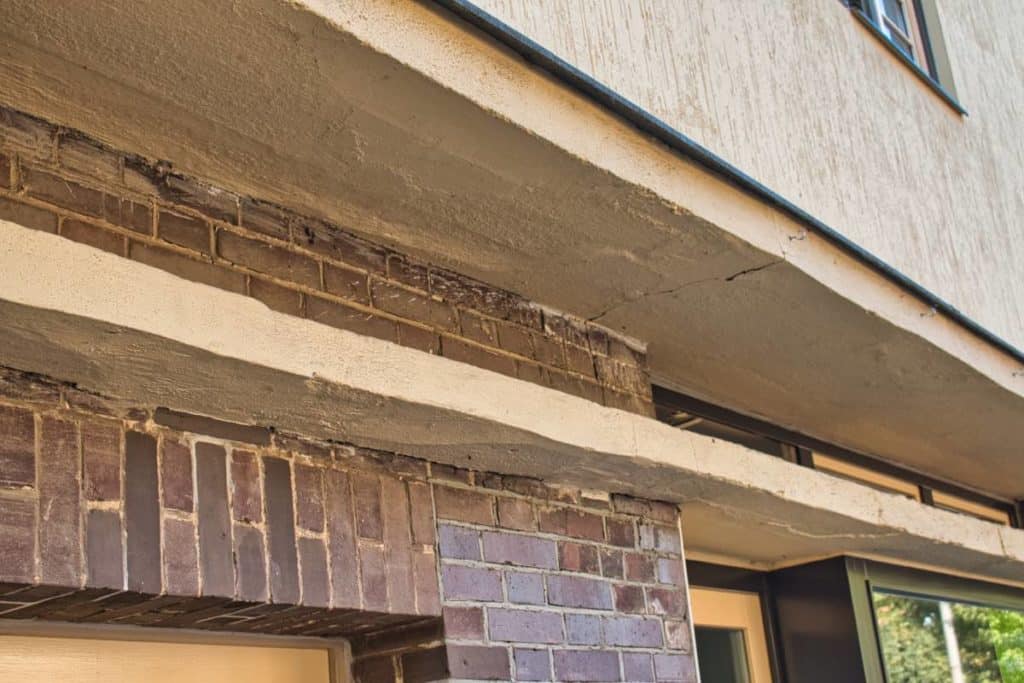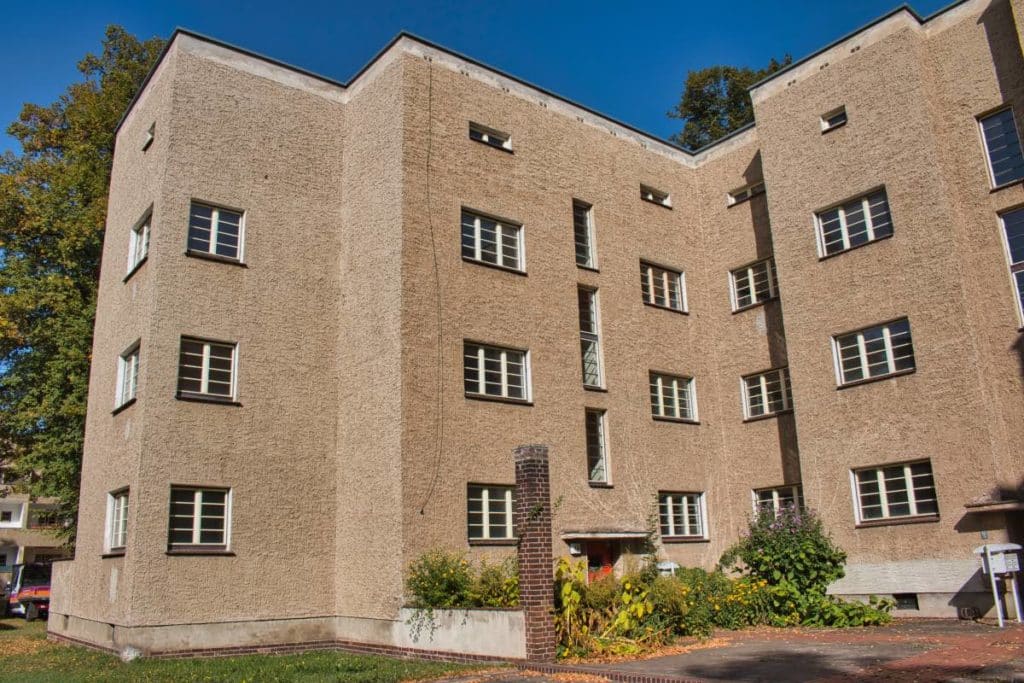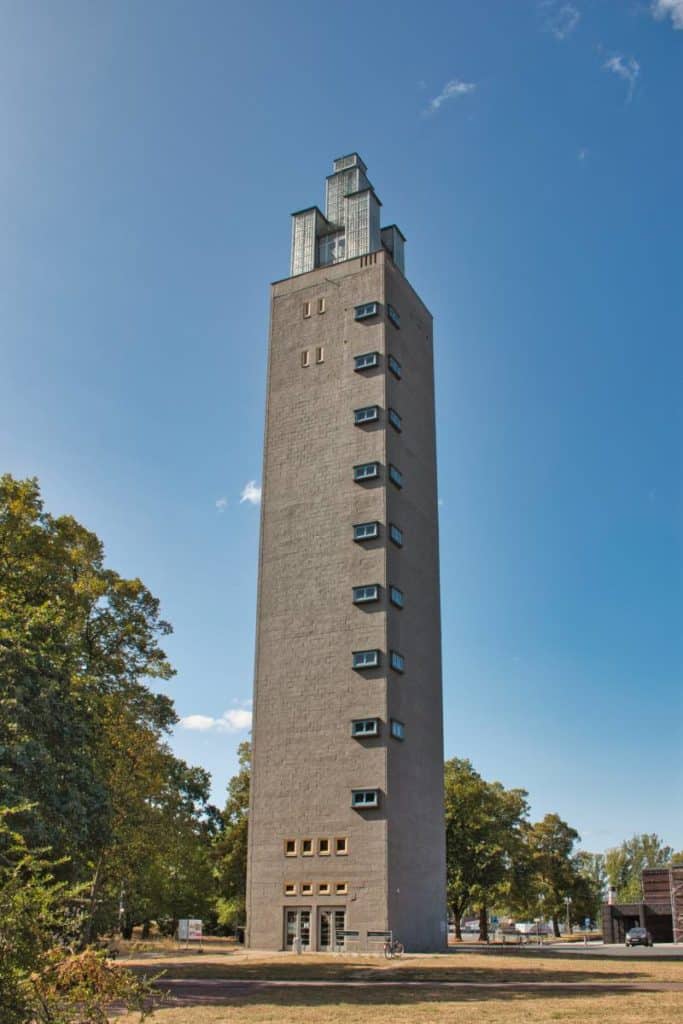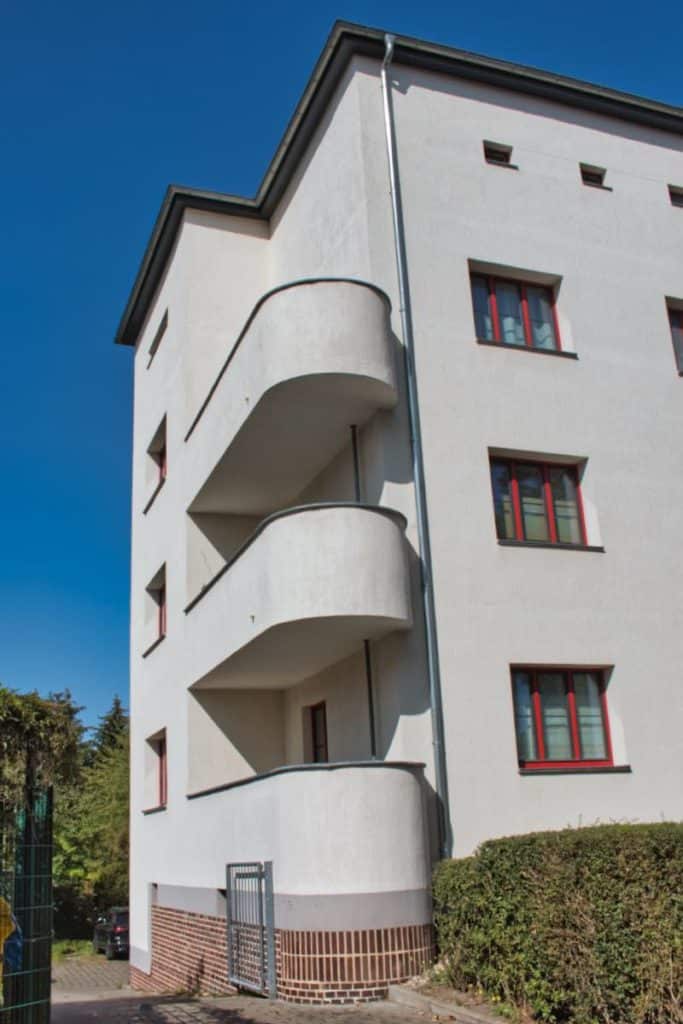Many people probably only know Magdeburg from the highway signs on the A2 and A14 which are some of Germany’s most important Autobahns. However, the city on the Elbe is well worth a visit and has several sights well worth seeing, including the Hundertwasserhaus, the Magdeburg Cathedral and the Elbauenpark with the Millennium Tower. However, only a few people know that Magdeburg is a real Mecca for fans of modernism. In the 1920s, the current capital of Saxony-Anhalt experimented as extensively with the so called Neues Bauen (New Construction) as perhaps only Chemnitz and Berlin. That’s why we want to introduce you to the most beautiful places of the Magdeburg Modernism.
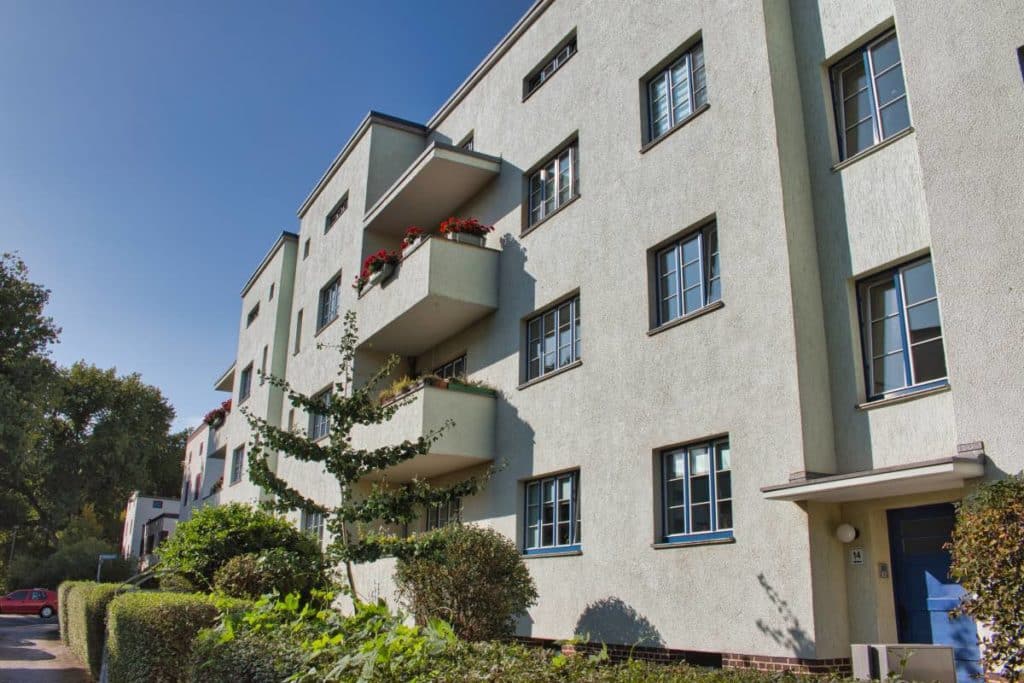
The Interwar Period as a laboratory in Magdeburg
Due to its location and importance, Magdeburg was a fortress city for centuries and thus initially limited in its growth. However, industrialization also caused Magdeburg to grow strongly. The resulting economic hardship was exacerbated by the First World War. Housing was scarce, and conditions in tenements were often unsanitary. Progressive politicians in particular, who had been elected to office by entirely new groups of voters as a result of the revolution and the suffrage it introduced, were under pressure to create affordable housing. This also made it mandatory to leave old principles behind in favor of new ideas.
Hermann Beims as the father of Magdeburg Modernism

Hermann Beims became mayor of Magdeburg in 1919. He was actually a carpenter and labor official from a small town in what is now Lower Saxony. However, he had already come to Magdeburg before the First World War. In addition to his position as mayor, he was also a member of the National Assembly and then the Reichstag. A pragmatist, he sought solutions to urban housing problems. Beims even wanted to develop Magdeburg into the capital of Central Germany – and let the city grow to 700,000 inhabitants. In his plans for expanding the city with experimental buildings, he repeatedly referred to the Magdeburg rights as a sign of local self-government. This enabled Magdeburg to become the leading city of the Neues Bauen. More building projects were implemented here than by the Bauhaus in Weimar or Dessau.
Even though Magdeburg did not reach 700,000 inhabitants, around 11,000 apartments were built between 1925 and 1932 as part of the Neues Bauen program. Beims brought well-known architects and urban planners to Magdeburg for this purpose. Bruno Taut developed the General Development Plan for the city and involved other progressive minds such as Johannes Göderitz and Carl Krayl. Mayor Hermann Beims also reformed other areas of urban life. Initially, schools and social institutions such as soup kitchens were built. The city established a health department and hired school doctors and school dentists. Infant mortality in the city was significantly reduced.
Magdeburg as a city of art – Die Kugel
In art, too, Magdeburg developed into an important center of late Expressionism after the First World War. Revolutionary-minded artists joined together in the artists’ association Die Kugel (The Sphere), which printed magazines and propagated their ideas and organized discussion groups. The group included painters such as August Bratfisch, the architect Adolf Behne, the graphic artist Bruno Beye and the writer Erich Weinert. Even though the group only existed until 1923, it provided important key impulses for the implementation of the reform ideas and the realization of Neues Bauen in Magdeburg.
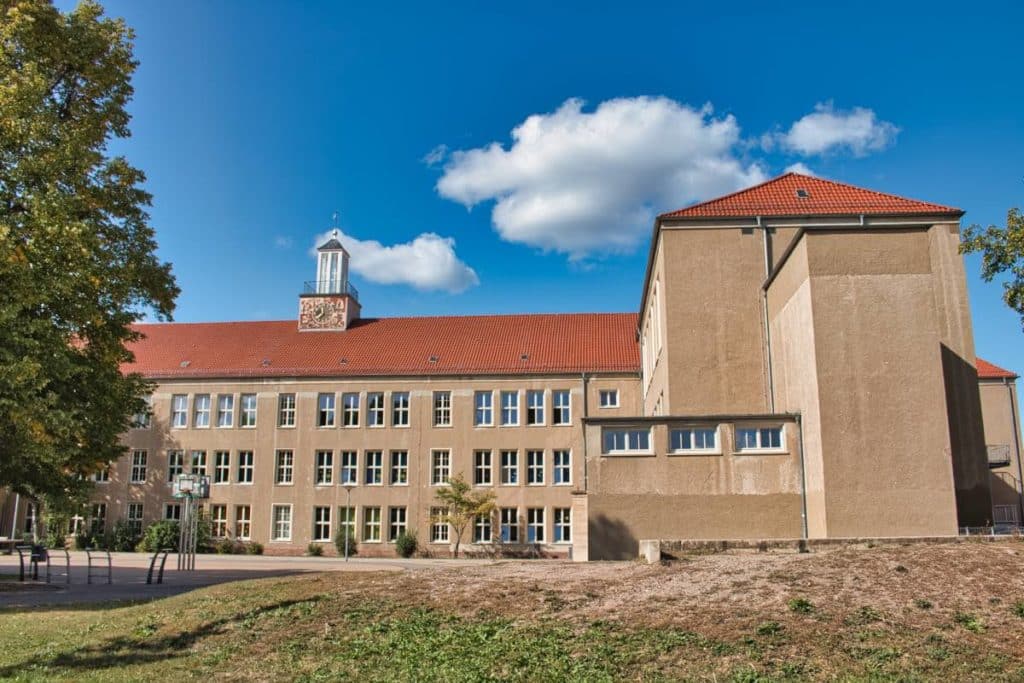
Magdeburg as a reform city in the school system
In addition to the architectural and artistic developments during the period of the Weimar Republic, new approaches to education also became possible. Above all, reform pedagogical ideas prevailed. Magdeburg was a center of this development. Here, the tripartite school system was to be abolished, church and state were to be separated, and gender segregation in schools was partially abolished. Hans Löscher became a city school board member and founded the first experimental reform school as early as 1922. In 1928, the people of Magdeburg enforced municipal self-government in the school system. Even before that, eight more reform schools had been opened.
General Development Plan for Magdeburg by Bruno Taut
The most progressive developments, however, were in urban planning. As early as 1913, Bruno Taut had made the first attempts at New Building in Magdeburg and developed the Garden City Reform, which showed the first rudiments of his ideas. Based on these shown works, Hermann Beims appointed Bruno Taut as city planning director of Magdeburg in 1921. Although Taut himself built only a few buildings such as the exhibition hall “Stadt und Land” (today Hermann-Gieseler-Halle), he influenced the urban development of Magdeburg for years to come through the General Development Plan.
He also set accents in the press with a call for the colorful design of Magdeburg’s facades, which brought the city great attention. Since he saw few opportunities for himself in Magdeburg after the completion of the General Development Plan, Taut left his position in Magdeburg as early as 1924 and began major projects in Berlin, such as the Hufeisensiedlung. His successor in Magdeburg was Johannes Göderitz.
Hermann-Beims-Siedlung – Living rethought
One of Magdeburg’s best-known modernist housing estates was built west of the city center on Große Diesdorfer Straße. Johannes Göderitz was responsible together with Konrad Rühl, Gerhard Gauger, Adolf Otto and Willy Zabel. The housing estate, now named after the mayor Hermann Beims, are still the best example of how the ideas of Neues Bauen were implemented in Magdeburg. The new housing estate was greener, the courtyards were larger, the apartments had plenty of light and could be easily ventilated. Also, the houses were colored with their elements such as windows and doors. Beims once said about them:
“The new housing should satisfy the demands for health, for well-being, for sunshine, for good air, for good children’s playgrounds and green spaces.”
Hermann Beims
There were also to be no more side wings and back houses. All this was a considerable improvement on the tenements and old houses in which people had lived crowded together due to industrialization.
The Wohnungsbaugesellschaft Magdeburg is therefore also very proud of the settlement and has therefore furnished one of the apartments as a museum and model apartment. A total of around 2,000 apartments were built in the Hermann-Beims-Siedlung, which was only about one third of the planned apartments. After the main construction phase until 1929, it was more common facilities that were built, such as the Flechtinger Straße children’s house, which is still in existence today.
Wilhelm Deffke and the German Theater Exhibition 1927
The well-known graphic artist Wilhelm Deffke became head of the Reich Sugar Exhibition in Magdeburg in 1924 on the recommendation of Bruno Taut. He had already designed well-known advertising posters at that time. Today he is considered the father of logo design. Shortly thereafter, he took over the post of director of the School of Arts and Crafts and, in this context, also became responsible for the German Theater Exhibition in 1927. This show comprehensively presented the theater of the time. Revolutionary concepts were presented. In the performances there were completely new productions to be seen, which were as spectacular as those of Les Kurbas in the Soviet Kharkiv of that time. Newspapers from Great Britain, France and the USA reported on the exhibition and indeed Magdeburg became a world city for a few months, as desired by Beims.
Stadthalle – Exhibition Hall – Masterpiece of Magdeburg Modernism
And the exhibition spaces and buildings were also partly responsible for this. For the German Theater Exhibition, the Stadthalle in Rotehornpark was built in just four and a half months according to plans by Johannes Göderitz and Wilhelm Deffke. The Stadthalle is particularly striking, however, because of its brick facade. The hall was embedded in a complete concept and formed an inner courtyard with the other buildings. However, the other exhibition halls were destroyed during the Second World War. Glass blocks were also integrated into the steel skeleton structure.
The hall was extremely versatile and could be used for many types of events. The builders also had a huge Sauer organ installed in the hall. Concerts were held here on Sundays in the following years. In this way, the Social Democrats wanted to offer an alternative to the organ concerts in the churches. Unfortunately, the organ was lost with the interior of the town hall during the great bombing raid on Magdeburg in 1945. Nevertheless, the hall was rebuilt and is still used for concerts today.
Albinmüller Tower – Tower of the atheist church
In addition to the Stadthalle, other buildings were built that were part of the ensemble. The Albinmüller Tower is one of the city’s landmarks and, due to its unusual shape and location as a campanile, a real peculiarity. Together with the town hall, this reinforces the impression of an atheistic church. The 63-meter-high building also served as a lookout tower during the 1927 theater exhibition, and the glass superstructure was even a restaurant at the time. It was designed by Albin Müller, who as an artist simply called himself Albinmüller.
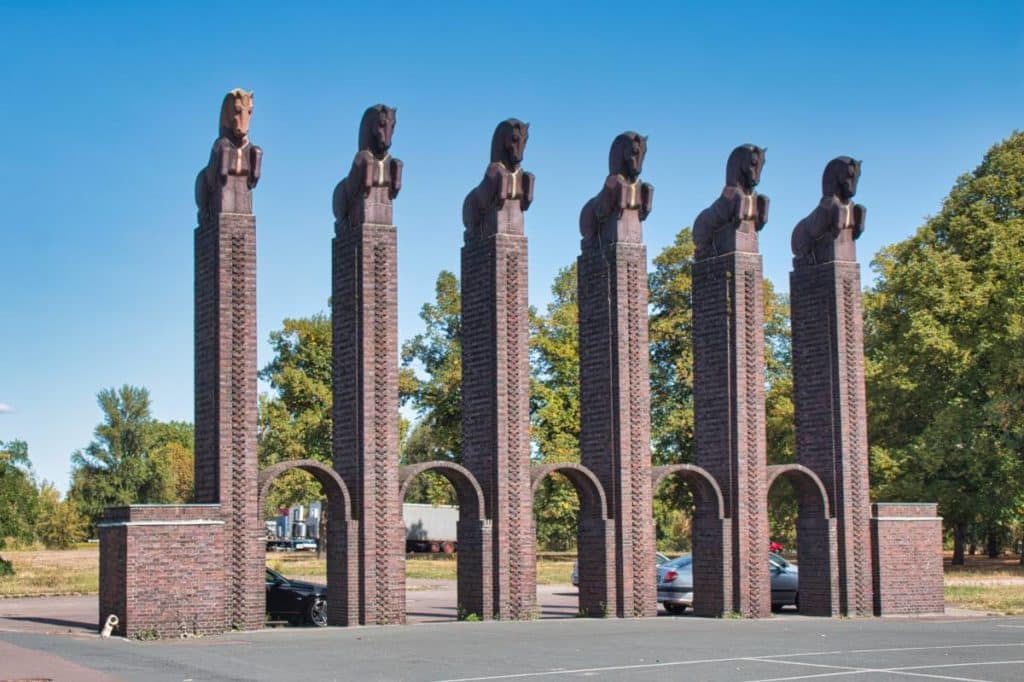
Horse Gate – Forgotten Landmark
Today, cars park next to the Horse Gate and rarely allow for a flawless photo. This is a pity, because this symbol of Magdeburg’s modernism actually deserves much greater appreciation. The Horse Gate was the northern end of the ensemble for the theater exhibition and the main connection between the Court of Honor and the adjacent amusement park. Because the construction management did not completely grant the artist Albinmüller the money for the design, he simply collected the financing for it himself.

Light steles – enlightenment for the new age
For a long time, the light steles, which were erected especially for the 1927 theater exhibition, led a sad existence. Walkers thought they were better flower pots. But in 2013 they were extensively renovated and shine in new splendor. The nine-meter-high light steles were supposed to herald a new era marked by enlightenment. Unfortunately, they were followed by one of the darkest eras in German history.
Other sights of Magdeburg Modernism
Cracau Estate
In the Magdeburg General Development Plan, Bruno Taut had already designated a settlement in Magdeburg-Cracau. A large area of the Magdeburg fortress had previously stood here. Initially, three-story residential buildings were built. They had flat roofs, which was one of the principles of Neues Bauen. Most of the buildings were constructed between 1929 and 1931. They were cubic in design and had large inner courtyards so that the lower floors also received sufficient light.
The rounded balconies give them an interesting touch, similar to the Bauhaus buildings in Tel Aviv. After all, as in the Beims estate, 2,000 apartments were also built here. This helped tremendously to combat the housing shortage. Later buildings in the Cracow settlement abandoned this style. In 1938, the buildings were given gable roofs again, entirely in the Heimat-Kitsch style of the National Socialists. The era of New Building had come to an end with the Cracau Settlement.

Faber Skyscraper
One of the outstanding examples of modern architecture in Magdeburg stands directly at the main train station. Moreover, this used to be my own workplace. At least during events. As a journalist, I learned my trade at the Magdeburger Volksstimme, which is still partly located in the high-rise building of the former Faber publishing house. Back then, too, I admired the shape of the building and was particularly impressed by the glass penthouse.
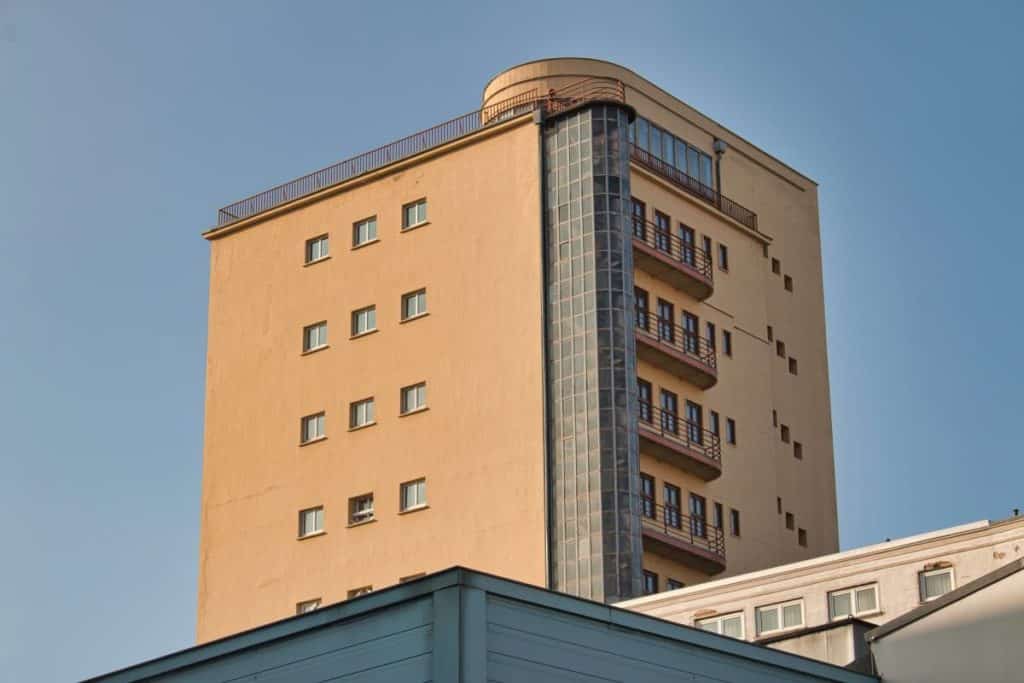
Strictly speaking, however, it is a semicircular weather station that makes the building so special. Together with the glass stair tower, the building presumably acted at the time for the promises of the new age. It was built from 1930 to 1932 and, at 45 meters, was also the city’s first high-rise building. However, shortly after its opening, the Volksstimme of the Faber publishing house was banned by the Nazis in April 1933. After the war, however, it was re-established in 1947 and became the district newspaper of the SED. In 1992, Bauer-Verlag from Hamburg bought the Volksstimme and wanted to have the building demolished. Fortunately, the demolition was prohibited by the State Administration Office and so the gem stands to this day.
OLi Movie Theater
Although the OLi cinema in Olvenstedter Straße was not opened until 1936 and thus already under National Socialism, it is nevertheless a monument to New Building. This is because the building had already been built earlier for the Dehne company. At the entrances you can still see sculptures for the Dehne forwarding company, created by Rudolf Wewerka, who was an important sculptor. The house design with the cubic oriel even came from Carl Krayl. The art house cinema is still a cultural beacon in the district.

Heimat Estate with the Bowed House
Just a few meters further on, another highlight of Neues Bauen can be seen: the Heimat Housing Estate. On Olvenstedter Platz, the Bowed House, designed by Hans Holthey in 1930, can also be seen here. The name of the settlement northwest of it goes back to the Magdeburger Heimat Gemeinnützige Bau- und Siedlungsgesellschaft.
Here, too, there are large green interior areas, which should allow light in the apartments on the lower floors. Since different floors were built here, the settlement looks less monotonous than others. The buildings are also laid out in strange shapes, because the plots of land at that time already had a strange shape and the architecture of the settlement takes this into account.
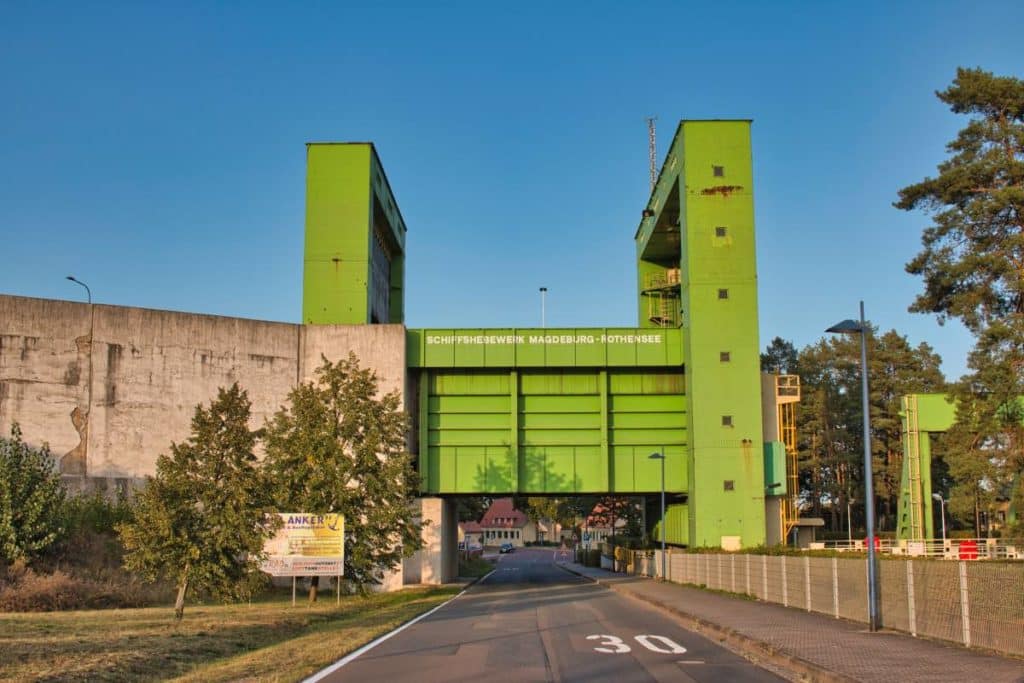
Rothensee Ship Lift
The spread of shipping throughout the country also made it important to expand the waterways. It was not until the mid-twenties that the plans for the Mittelland Canal, which was to create a connection from the Ruhr region to Berlin, were completed. The planned route also required a ship lift, which was then also built in Magdeburg-Rothensee. The engineer Rudolf Mussaeus was responsible.
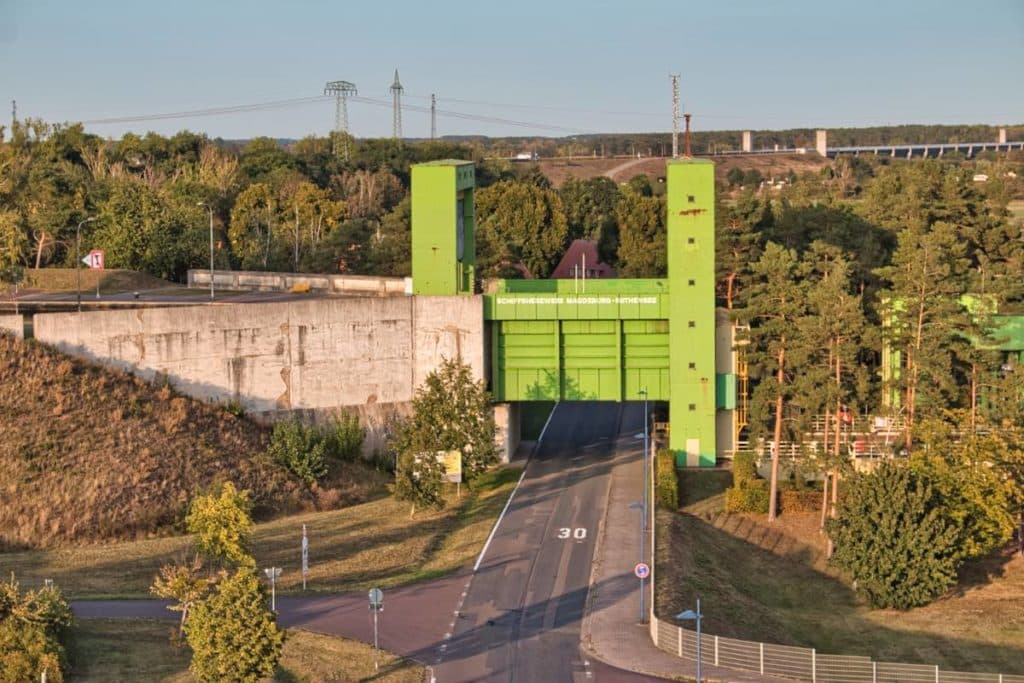
For the technical challenges, he applied principles that were already known from the submarines – this was revolutionary in the twenties of the 20th century. By the principle, an engine with the power of only 4 midsize cars manages to move weights of 5400 tons. The design is also very modernistic and simple. A visit is worthwhile and should be undertaken quite soon, because how long the hoist will continue to operate is unclear. It is considered cost-intensive and could therefore be shut down at any time. A trip through the ship lift with an excursion steamer from Magdeburg is also a special experience.
Germany Book tips
In English there are yet no travel books about Magdeburg. So you will need to cope with more general books that we can recommend.
Surprisingly there is a publication by the German publisher Merian in English available on Saxony-Anhalt which gives you a good idea specifically about the state.
The Lonely Planet for Germany gives you a good overview over this gorgeous country, suggests itineraries and tells you where else to go nearby.
- DK Eyewitness (Author)
DK presents you with 24 ideas for easy roadtrips in Germany. Some nice itineraries, although the book focuses more on the West of the country.










